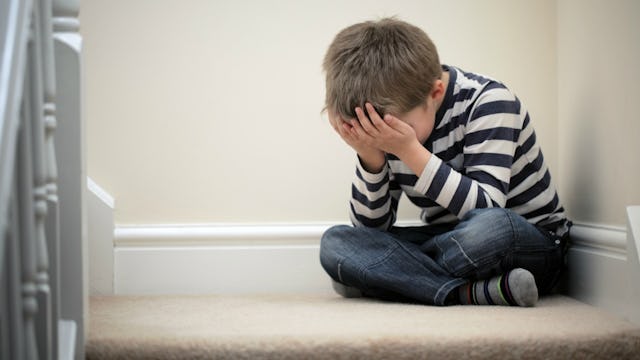Use The 'Train Analogy' To Help You Deal With Your Kid's Tantrums

Parenting can make you feel like you’ve been hit by a truck some days, but here’s a train metaphor — okay, actually it’s an analogy — that might actually help. In fact, it just might change the way you deal with everything from middle-of-aisle-two tantrums to tween door slamming and teen curfew violations.
We’ve all been there. We’ve all seen our kids struggle through an emotional outburst or frustration. And because we know it feels like torture to be in these tough spots, we try to distract them. After all, we distract ourselves with phones, shopping, eating, and keeping busy. So why wouldn’t we want to distract our kids from their own emotional angst?
Well, because it turns out distracting them doesn’t actually help.
And that’s where the “train analogy” comes in.
Here’s the deal: the train analogy is the idea that you are a train riding through a tunnel of your feelings. You need to get to the other side on your own — without distractions — in order to get over your feelings and move on.
Turns out it can actually work in our own lives too, not just when it comes to our parenting tactics.
While we have the best of intentions — no one wants to see their kids in pain — we also use distractions for our own sake too. Because let’s face it, it’s a pain in the ass when our kids are having a meltdown. There are times we just want to move on and have them shut up about the damn cookie, the balloon that floated out of their hands, or their favorite book you read to them every night that’s gone missing.
But when we distract them from their emotional outburst, what we are really doing is making their feelings spiral because they don’t feel validated. We’re also taking away any chance they have of sorting out their feelings for themselves.
Mom Katie M. McLaughlin recently wrote about how she applied the train analogy to her son’s emotional outburst after he left his lovey in his Grandmother’s car. He had to go without it for the night for the first time in his life, but she resisted the urge to say things like “You will be fine” and “It’s only one night.”
Instead, she applied the train analogy, which she had learned in a therapy session years prior, she let her son cry and go through his tunnel of emotions on his own terms without interfering. It took him all of 8 minutes to get through to the other side. He was then calm, able to pick out a different stuffed animal to sleep with, and he’d built some resistance for the next uncomfortable situation he will be faced with.
Let’s be honest, it’s tough to ignore this urge to make our kids feel better when they’re uncomfortable. But the times when I’ve applied the train analogy with my own kids, the situation worked out better and my kids came out happier because of it.
For instance, when my oldest was 3, he had a pacifier in his mouth more often than not. When we were leaving for a road trip, I couldn’t find it anywhere. I put him in the car anyway, and of course, a panicked meltdown ensued. Too exhausted to deal with his meltdown, he started crying and I had zero energy to talk over his screams, so I didn’t.
I let him ride through the emotional tunnel. I didn’t distract him by rushing to get a new pacifier. And I didn’t invalidate his feelings by telling him not to worry about it. While it was a long 15 minutes of him crying, but when his tears stopped, he eventually realized he was going to be okay. I told him I knew he was sad without his pacifier, but he ultimately survived the trip pacifier-free.
Now that my kids are teenagers, I still have to remember the train analogy because distracting them with statements like “you need to move on” or telling them they’re “better off” after a friend has hurt their feelings doesn’t give them a chance to self-regulate, ride through the emotions, and build resistance to difficult situations.
As parents, our knee-jerk reaction is to make it better for our kids. And the train analogy doesn’t contradict that need; it just changes the way that we go about doing that.
We build strong, confident, able children by letting them push their own way through the emotional tunnel. We teach them to do this by backing off and not trying to fix everything for them the moment they stop crying.
There’s no magic formula to parenting, of course, but it’s important to teach our kids these this lesson now, as hard as it may be for all involved, but our hard work (and their handwork) will have huge gains.
This article was originally published on